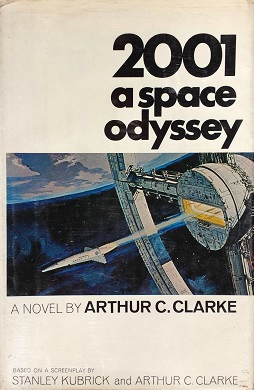
Retroactive continuity, or retcon for short, is a literary device in which facts in the world of a fictional work that have been established through the narrative itself are adjusted, ignored, supplemented, or contradicted by a subsequently published work that recontextualizes or breaks continuity with the former.

"The Sentinel" is a science fiction short story by British author Arthur C. Clarke, written in 1948 and first published in 1951. Its plot and ideas influenced the development of the 1968 film 2001: A Space Odyssey and its corresponding novel.

2010: Odyssey Two is a 1982 science fiction novel by British writer Arthur C. Clarke. It is the sequel to his 1968 novel 2001: A Space Odyssey, though Clarke changed some elements of the story to align with the film version of 2001.

Stephen Baxter is an English hard science fiction author. He has degrees in mathematics and engineering.

Alien invasion or space invasion is a common feature in science fiction stories and film, in which extraterrestrial lifeforms invade the Earth to exterminate and supplant human life, enslave it, harvest people for food, steal the planet's resources, or destroy the planet altogether. It can be considered as a science-fiction subgenre of the invasion literature, expanded by H. G. Wells's seminal alien invasion novel The War of the Worlds, and is a type of "first contact" science fiction.
The Space Odyssey series is a series of science fiction novels by the writer Arthur C. Clarke. The first novel was developed concurrently with Stanley Kubrick's film version and published after the release of the film. The second was made into a feature film, released in 1984, respectively. Two of Clarke's early short stories have ties to the series.

3001: The Final Odyssey is a 1997 science fiction novel by British writer Arthur C. Clarke. It is the fourth and final book in Clarke's Space Odyssey series.
The concept of self-replicating spacecraft, as envisioned by mathematician John von Neumann, has been described by futurists and has been discussed across a wide breadth of hard science fiction novels and stories. Self-replicating probes are sometimes referred to as von Neumann probes. Self-replicating spacecraft would in some ways either mimic or echo the features of living organisms or viruses.

In Arthur C. Clarke's Space Odyssey series, Monoliths are machines in black cuboids whose sides extend in the precise ratio of 1 : 4 : 9 (12 : 22 : 32) built by an unseen extraterrestrial species whom Clarke dubbed the Firstborn and who he suggests are the earliest highly intelligent species to evolve in the Milky Way. In the series of novels (and the films based on these), three Monoliths are discovered in the Solar System by australopithecines and their human descendants. The characters' responses to their discoveries drives the plot of the series and influences its fictional history, particularly by encouraging humanity to progress with technological development.

2001: A Space Odyssey is a 1968 science fiction novel by British writer Arthur C. Clarke. It was developed concurrently with Stanley Kubrick's film version and published after the release of the film. Clarke and Kubrick worked on the book together, but eventually only Clarke ended up as the official author. The story is based in part on various short stories by Clarke, including "The Sentinel". By 1992, the novel had sold three million copies worldwide. An elaboration of Clarke and Kubrick's collaborative work on this project was made in the 1972 book The Lost Worlds of 2001.

Time's Eye is a 2003 science fiction novel co-written by British writers Arthur C. Clarke and Stephen Baxter. It is the first book in the A Time Odyssey series. The next book in the series is Sunstorm.

First contact is a common theme in science fiction about the first meeting between humans and extraterrestrial life, or of any sentient species' first encounter with another one, given they are from different planets or natural satellites. It is closely related to the anthropological idea of first contact

Sunstorm is a 2005 science fiction novel co-written by British writers Arthur C. Clarke and Stephen Baxter. It is the second book in the series A Time Odyssey. The books in this series are often likened to the Space Odyssey series, although the Time Odyssey novels ostensibly deal with time where the Space Odyssey novels dealt with space. The first book in the series was Time's Eye.

Firstborn is a 2007 science fiction novel by British writers Arthur C. Clarke and Stephen Baxter. It is the third book, billed as the conclusion of the A Time Odyssey series.
Since its premiere in 1968, the film 2001: A Space Odyssey has been analysed and interpreted by numerous people, ranging from professional movie critics to amateur writers and science fiction fans. The director of the film, Stanley Kubrick, and the writer, Arthur C. Clarke, wanted to leave the film open to philosophical and allegorical interpretation, purposely presenting the final sequences of the film without the underlying thread being apparent; a concept illustrated by the final shot of the film, which contains the image of the embryonic "Starchild". Nonetheless, in July 2018, Kubrick's interpretation of the ending scene was presented after being newly found in an early interview.

Sir Arthur Charles Clarke was a British science fiction writer, science writer, futurist, inventor, undersea explorer, and television series host.
The following is a list of works by Arthur C. Clarke.

Ancient astronauts have been addressed frequently in science fiction and horror fiction. Occurrences in the genres include:
In his lifetime Arthur C. Clarke participated in film, television, radio and other media in a number of different ways.










